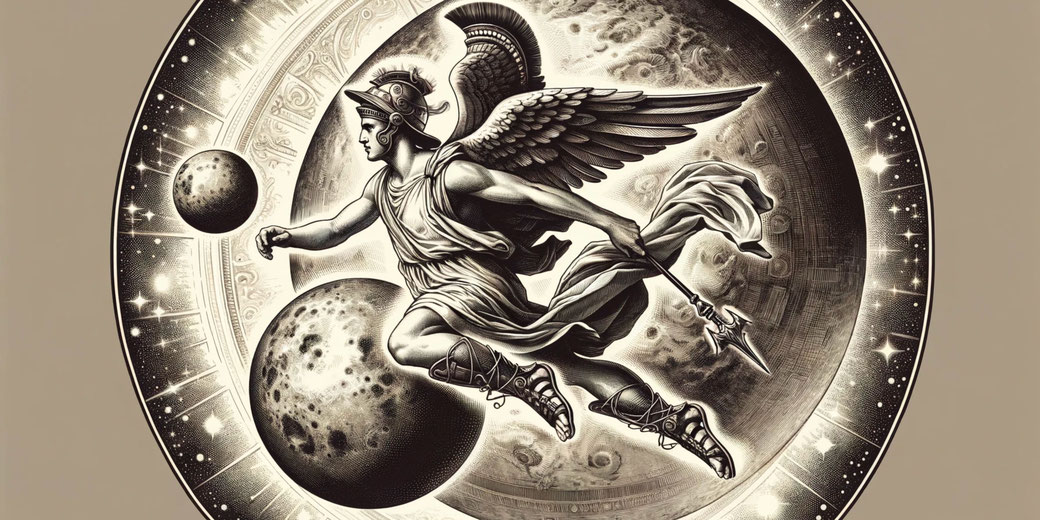Why are the planets named after Roman gods?

Gazing up at the night sky, we see more than just sparkling stars; we witness a celestial gallery adorned with names from ancient Roman mythology.
Each planet carries a name borrowed from the Roman gods: Mercury, Venus, Mars, Jupiter, and Saturn.
But why were these celestial bodies christened after Roman deities?
And how did the mythology of a bygone era shape the way we view our solar system today?
How the Romans thought about their gods
In the ancient Roman mind, the night sky was a canvas of cosmic drama, where deities played out tales of passion, power, and intrigue.
Roman gods, mighty and capricious, were believed to reign over every aspect of life, and naturally, this divine rule extended to the skies.
The planets, moving across the sky unlike fixed stars, captured the imagination of Roman astronomers and were seen as divine messengers or embodiments of their gods.
Early Roman astronomers, akin to priests, spent nights charting the skies, noting the motions of planets and the phases of the moon.
These observations were not just for curiosity or science; they were crucial to the Roman way of life.
The Romans, like many ancient cultures, turned to the skies for omens, guidance, and signs from the gods.
Despite their limited technological means, Roman astronomers could observe the planets' movements and differentiate them from stars, which they perceived as fixed points of light.
The planets, with their distinct motions and appearances, demanded a different kind of attention – one that was befitting of divine entities in Roman culture.
The calendar, agriculture, religious festivals, and even military campaigns were all influenced by celestial movements.
To the Romans, the planets were not mere celestial bodies but were imbued with divine character and purpose.
The Greeks had already identified and named planets after their gods, and the Romans, in their cultural assimilation, adopted these names and adapted them to their own pantheon.
For instance, the Greeks named the brightest planet in the sky after Aphrodite, their goddess of love.
When the Romans adopted this system, they replaced Aphrodite with Venus, their own goddess of love and beauty.
They saw Venus as not just a bright spot in the sky, but as the embodiment of beauty and love, reflecting the qualities of the goddess Venus.
Similarly, Ares, the Greek god of war, known for his ferocity and combat prowess, became Mars in Roman mythology, retaining the aggressive and martial symbolism associated with the red planet.
In a similar way to Venus, Mars was not just a red planet; it was the fierce and powerful god of war, mirroring the planet's reddish hue and the Roman spirit of conquest.
This blend of mythology and astronomy shows how the Romans sought to understand their universe.
They found order and meaning in the skies, creating a system where the cosmos and culture were inextricably linked.

The Roman gods each planet was named after
The planets of our solar system bear names that are echoes of ancient Roman mythology, each tied to a deity that encapsulates the planet's unique characteristics and movements.
Mercury, named after the swift messenger of the gods, mirrors the planet's rapid orbit around the sun, the fastest in our solar system.
This association with speed and agility perfectly aligns with the Roman god Mercury, known for his fleet-footedness and role as a herald.
Venus, radiant and shining brighter than any other planet in our night sky, takes its name from the Roman goddess of love and beauty.
The planet's brilliance and beauty made it a natural choice to be associated with Venus, a deity revered for her charm and allure.
Mars, with its distinct red hue, resonates with the Roman god of war. This color, reminiscent of blood and fire, made Mars an apt name for the planet, reflecting the aggressive and warlike nature attributed to the god Mars.
The planet's reddish appearance thus became symbolic of the deity's martial prowess and strength.
Jupiter, the largest planet in our solar system, is named after the king of the Roman gods.
Its size and prominent presence in the night sky made it a fitting representation of Jupiter, a deity known for his power and authority.
This naming also reflects the importance of Jupiter in Roman religion as the ruler of gods and men.
Saturn, with its magnificent rings and slower orbit, is named after the Roman god of agriculture and time.
The name captures the planet's more distant and serene presence in the sky.
Saturn, the deity, was associated with sowing and harvest, and his connection to time aligns with the planet's lengthy journey around the sun.
Why were new-found planets also named after the gods?
The invention of the telescope in the early 17th century marked a pivotal moment in astronomical history.
With this new tool, astronomers could see the heavens with unprecedented clarity and detail.
Galileo Galilei, one of the first to use the telescope for astronomical purposes, made groundbreaking observations that challenged prevailing notions about the solar system.
He discovered moons orbiting Jupiter, revealing that not everything in space revolved around the Earth, a concept that was revolutionary at the time.
These advancements led to the discovery of planets beyond the five known to ancient astronomers.
Uranus was discovered in 1781 by William Herschel, expanding the known boundaries of the solar system.
This discovery was followed by Neptune in 1846 and later Pluto in 1930, though Pluto was reclassified as a dwarf planet in 2006.
With each new discovery, the naming convention established by the Romans was continued, honoring the tradition of naming planets after mythological figures.
Uranus was named after an ancient Greek deity, a nod to the Greek roots of Roman mythology, while Neptune and Pluto were named for Roman gods of the sea and the underworld, respectively.
The progress in astronomical tools and techniques not only expanded our cosmic map but also refined our understanding of the planets themselves.
Features like the rings of Saturn or the Great Red Spot of Jupiter were observed in detail, adding to the richness of our knowledge about these distant worlds.
This era of discovery and exploration reaffirmed the human fascination with the cosmos and demonstrated how technological advancements could deepen our understanding of the universe.

How have other cultures named the planets?
The practice of naming celestial bodies is a universal phenomenon, with each culture bringing its own perspective and mythology to the cosmos.
Unlike the Roman approach of naming planets after their gods, other cultures have adopted different methods and rationale for naming celestial bodies, often reflecting their unique worldviews and mythological stories.
In ancient Mesopotamia, one of the earliest civilizations to engage in systematic astronomical observations, planets were named after their gods, similar to the Romans.
However, their choice of names was rooted in the Sumerian and Babylonian pantheons.
For instance, Jupiter was known as Marduk, a chief deity in the Babylonian mythology.
This naming convention underscores the deep connection ancient Mesopotamians saw between celestial events and their religious beliefs.
The ancient Egyptians, too, had a rich astronomical tradition. Their naming of celestial bodies was often linked to their gods and goddesses, but with a unique emphasis on celestial events' relation to the Nile River and agricultural cycles.
For instance, the star Sirius was associated with Isis, a key goddess in Egyptian mythology, and its heliacal rising heralded the annual flooding of the Nile.
In Chinese astronomy, the planets were traditionally named based on their physical characteristics and the elements they were thought to represent in Chinese philosophy.
Venus, known as the 'Metal Star', was associated with metal in the Wu Xing system.
This approach reflects a more philosophical and elemental understanding of the cosmos, distinct from the mythological personifications seen in Roman and Greek traditions.
The Hindus named the planets after their gods as well, but their system reflects the intricacies of Hindu mythology and astrology.
For example, Mars is named Mangala, after the Hindu god of war, bearing a conceptual similarity to the Roman Mars.
However, in Hindu tradition, the planetary gods have complex stories and attributes that are deeply intertwined with Vedic astrology and Hindu cosmology.
What do you need help with?
Download ready-to-use digital learning resources
Copyright © History Skills 2014-2025.
Contact via email
With the exception of links to external sites, some historical sources and extracts from specific publications, all content on this website is copyrighted by History Skills. This content may not be copied, republished or redistributed without written permission from the website creator. Please use the Contact page to obtain relevant permission.





